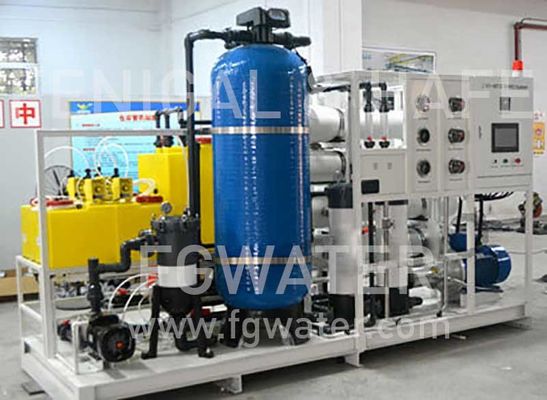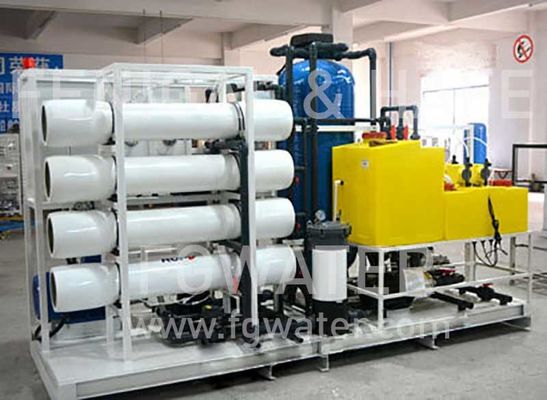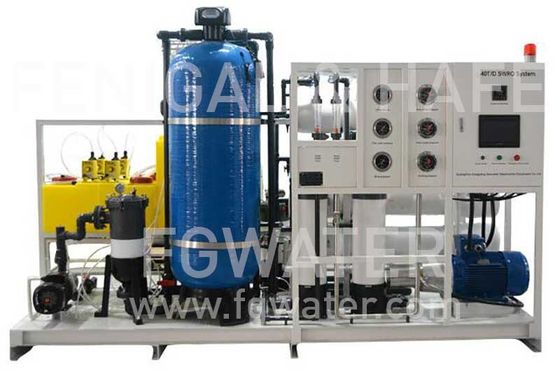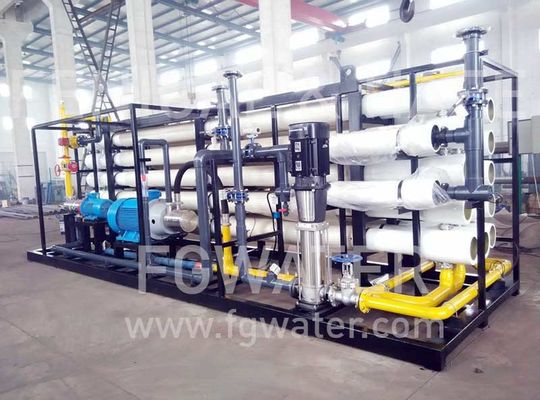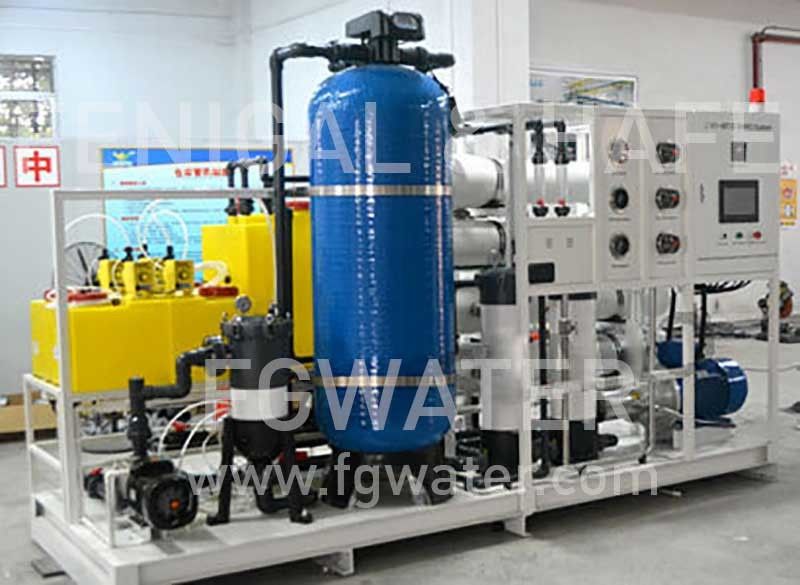Skid Mount 40000GPD Seawater RO System
Product Details:
| Place of Origin: | China |
| Brand Name: | Fenigal/OEM |
| Certification: | CE/NSF etc. |
| Model Number: | SX-8,000GPD~40,000GPD |
Payment & Shipping Terms:
| Minimum Order Quantity: | 1 Set |
|---|---|
| Price: | Negotiable |
| Packaging Details: | Standard Export Wood Crate/Carton or Naked wrapped by film |
| Delivery Time: | 15~30 days |
| Payment Terms: | T/T, Western Union, Paypal etc. |
| Supply Ability: | 50 set per month |
|
Detail Information |
|||
| Technology: | Reverse Osmosis | Design: | Skid Mount |
|---|---|---|---|
| Recovery Rate: | 30~50% | Feed TDS/ppm: | <42,000 |
| Water Temp.: | 5~35˚C | PH: | 4~9 |
| TSS/mg/L: | <5 | Silt Density Index: | <3 |
| Free Chlorine Mg/L: | 0 | Dissolved Iron Mg/L: | <0.1 |
| Warranty: | 1 Year | Material: | SS304/SS316L,carbon Steel |
| Voltage: | 380V,415V,220V,can Be Customized | Application: | Water Purification,Filtration,pharmceutical,drinking Water,food |
| Size: | Depends,1750*550*1650mm | Type: | Seawater Reverse Osmosis System |
| Function: | Water Purifying, Desalination | Desalination Rate: | 99%,99.7% |
| Control: | Electronic,Manual/PLC | Ro Membrane: | Hydranautics Or DOW,4040 |
| Pump: | Danfoss/CAT/CNP | ||
| High Light: | 40000GPD Seawater RO System,Skid Mount Seawater RO System,40000GPD sea water RO plant |
||
Product Description
Skid Mount 40000GPD Seawater RO System
SX series Industrial Seawater Reverse Osmosis Treatment System 8,000GPD~40,000GPD
SX – Series Reverse Osmosis Systems are engineered for seawater desalination and other high total dissolved solids (TDS) applications requiring high pressure pumps. The SX – Series Reverse Osmosis Systems are rated to handle total dissolved solids as high as 45,000.
The SX – Series Reverse Osmosis Systems range in capacity from 5.6 to 27.8 gallons per minute
(8,000 to 40,000 gallons per day) utilize a clean design that allows for convenient installation, user–friendly operation.
Featuring robust components for enhanced performance, the SX – Series Reverse Osmosis Systems include a duplex stainless steel axial piston pump, high pressure hoses, stainless steel valving and FRP membrane housings with duplex stainless steel side ports.
Standard Features
|
8 – inch Low Energy Seawater Membrane Elements 8 – inch Fiberglass Membrane Housings with Duplex Stainless Steel Side Ports (1000 psi) 2 Stage Glass–Reinforced, Polypropylene, Non–Metallic Pre–Filtration Housings 5 – Micron Sediment Pre–Filter (Stage 1) 1 – Micron Sediment Pre–Filter (Stage 2) Duplex Stainless Steel Axial Piston Pump Low and High Pressure Shut–Off Switch Pump Pressure Relief Valve S – 150 Pre–Programmed Computer Controller with Soft Start Permeate and Concentrate Rotameters Permeate TDS Monitoring Pre– and Post–Filter 316L Stainless Steel Pressure Gauges |
Pump and Concentrate 316L Stainless Steel Pressure Gauges PVC Feed Motorized Ball Valve 316L Stainless Steel Needle Concentrate Valve Epoxy Powder Coated Carbon Steel Frame Sch80 Low Pressure PVC Piping Electroplated 316L Sch80 Stainless Steel Piping Nitrile High Pressure Hose with Duplex Stainless Steel Connections Clean–In–Place (CIP) Ports with Valves Permeate Sample Ports Chemical Feed Port Chemical Feed Power Outlet Composite Permeate Flush Solenoid Valve PVC Permeate Divert Motorized Ball Valve 460VAC 3PH 60Hz |
Options and Upgrades
|
Micro-computer Controller Permeate and Concentrate Digital Paddlewheel Sensors VFD (Variable Frequency Drive) Programmable Logic Controller (PLC) with Touch Screen pH Sensor ORP Senso |
Clean–In–Place Skid–Mounted System Chemical Feed System 8 – inch Low Energy Seawater Membrane Elements (440 SF) Voltage Options: 220VAC 3PH 60Hz, 220VAC 3PH 50Hz, 380VAC 3PH 50Hz |
Product Specifications
| Models | SX – 1280 | SX – 2280 | SX – 3280 | SX – 4280 | SX – 5280 |
| Design | |||||
| Configuration | Single Pass | Single Pass | Single Pass | Single Pass | Single Pass |
| Feedwater TDS max (ppm)† | 38,000 | 38,000 | 38,000 | 38,000 | 38,000 |
| Standard Recovery % | 30 | 45 | 50 | 50 | 50 |
| Rejection and Flow Rates ††† | |||||
| Nominal Salt Rejection % | 99.8 | 99.8 | 99.8 | 99.8 | 99.8 |
| Permeate Flow Rate (gpm / lpm) | 5.60 / 21.00 | 11.10 / 42.00 | 16.70 / 63.00 | 22.20 / 84.00 | 27.80 / 105.00 |
| Minimum Concentrate Flow Rate (gpm / lpm) |
14 / 53 | 14 / 53 | 17 / 64 | 22 / 83 | 28 / 106 |
| Connections | |||||
| Feed Connection (in) | 2 FNPT | 2 FNPT | 2 FNPT | 2 FNPT | 2 FNPT |
| Permeate Connection (in) | 1 1/4 FNPT | 1 1/4 FNPT | 1 1/4 FNPT | 1 1/2 FNPT | 1 1/2 FNPT |
| Concentrate Connection (in) | 1 1/4 FNPT | 1 1/4 FNPT | 1 1/4 FNPT | 1 1/2 FNPT | 1 1/2 FNPT |
| Clean–in–Place Port (in) | 1 1/2 FNPT | 1 1/2 FNPT | 1 1/2 FNPT | 1 1/2 FNPT | 1 1/2 FNPT |
| Chemical Feed Port (in) | 1/2 NPT | 1/2 NPT | 1/2 NPT | 1/2 NPT | 1/2 NPT |
| Membranes | |||||
| Membrane(s) Per Vessel | 2 | 2 | 2 | 2 | 4 |
| Membrane Quantity | 2 | 4 | 6 | 8 | 10 |
| Membrane Size | 8040 | 8040 | 8040 | 8040 | 8040 |
| Vessels | |||||
| Vessel Array | 1 | 1:1 | 1:1:1 | 2:1:1 | 2:1:1:1 |
| Vessel Quantity | 1 | 2 | 3 | 4 | 5 |
| Pumps | |||||
| Pump Type | Axial Piston | Axial Piston | Axial Piston | Axial Piston | Axial Piston |
| Motor HP / KW | 20 / 15 | 20 / 15 | 25 / 19 | 40 / 30 | 40 / 30 |
| System Electrical | |||||
| Standard Voltage + Amp Draw | 460V, 60Hz, 3PH, 25.5A |
460V, 60Hz, 3PH, 25.5A |
460V, 60Hz, 3PH, 31A** |
460V, 60Hz, 3PH, 48.5A |
460V, 60Hz, 3PH, 48.5A |
| Systems Dimensions | |||||
| Approximate Dimensions* L x W x H (in / cm) | 144 x 41 x 75 / 366 x 104 x 190 |
144 x 41 x 75 / 366 x 104 x 190 |
144 x 41 x 75 / 366 x 104 x 190 |
144 x 41 x 75 / 366 x 104 x 190 |
144 x 41 x 85 / 366 x 104 x 216 |
| Approximate Weight (lbs / kg) | 2230 / 1060 | 2660 / 1206 | 3090 / 1400 | 3860 / 1750 | 4220 / 1920 |
Test Parameters: 35,000 TDS Filtered (5 – Micron), Dechlorinated, Municipal Feedwater, 65 psi / 4.50 bar Feed Pressure, 950 / 65.5 psi bar Operating Pressure, 77ªF / 25ªC, Recovery as stated, 7.0 pH. Data taken after 60 minutes of operation.
Does not include operating space requirements.
Varies with motor manufacturer.
Operating Limits
| Design Temperature (°F / °C) | 77 / 25 | Maximum SDI Rating (SDI) | < 3 |
| Maximum Feed Temperature (°F / °C) | 85 / 29 | Maximum Free Chlorine (ppm) | 0 |
| Minimum Feed Temperature (°F / °C) | 40 / 4 | Maximum Hardness (gpg) | 0 |
| Maximum Ambient Temperature (°F / °C) | 120 / 49 | Maximum pH (Continuous) | 11 |
| Minimum Ambient Temperature (°F / °C) | 40 / 4 | Minimum pH (Continuous) | 2 |
| Maximum Feed Pressure (psi / bar) | 72.5 / 5 | Maximum pH (Cleaning 30 Minutes) | 12 |
| Minimum Feed Pressure (psi / bar) | 45 / 3 | Minimum pH (Cleaning 30 Minutes) | 1 |
| Maximum Piping Pressure (psi / bar) | 950 / 66 | Maximum Turbidity (NTU) | < 1 |
Low temperatures and feedwater quality, such as high TDS levels will significantly affect the systems production capabilities and performance. Computer projections must be run for individual applications which do not meet or exceed minimum and maximum operating limits for such conditions.
System pressure is variable due to water conditions. Permeate flow will increase at a higher temperature and will decrease at a lower temperature.
Product flow and maximum recovery rates are based on feedwater conditions as stated above. Do not exceed recommended permeate flow.
![]()
More information about SWRO
What is seawater reverse osmosis?
Seawater reverse osmosis systems are designed to decline more than 99% of saline compromised within the feed water. These systems also incorporate a rinsing, chemical purifying apparatus to eliminate sodium chloride, avert scaling, and preserve system performance. There are two fundamental elements within every seawater reverse osmosis system, which are reverse osmosis membranes and high pressure feed pumps. These elements make up the center of any reverse osmosis system and need special consideration and application for successful operation.
Does reverse osmosis remove salt from seawater?
Yes, semipermeable membranes enable the feed water to pass through it at a much higher volume than dissolved salts. Reverse osmosis systems work by applying pressure as freshwater streams through its membranes to filter out the concentrated saline in the feed water, as well as minerals and pollutants. These unwanted impurities are either flushed away, recycled, or processed. Seawater reverse osmosis systems utilize more than one membrane to boost the load of purified water turned out each day.
What are the advantages of desalination plants?
Seawater desalination has become a vital alternative to the production of pure freshwater throughout the areas of the world without drinkable water. As other sources such as rivers, lakes, wells, and springs have become more exhausted due to excessive extraction, the ocean has provided an abundant supply of available water for human use. Although ocean water consists of elevated levels of salt, and therefore is unable to be utilized for consumption or most other purposes, seawater desalination has helped make it practical.


